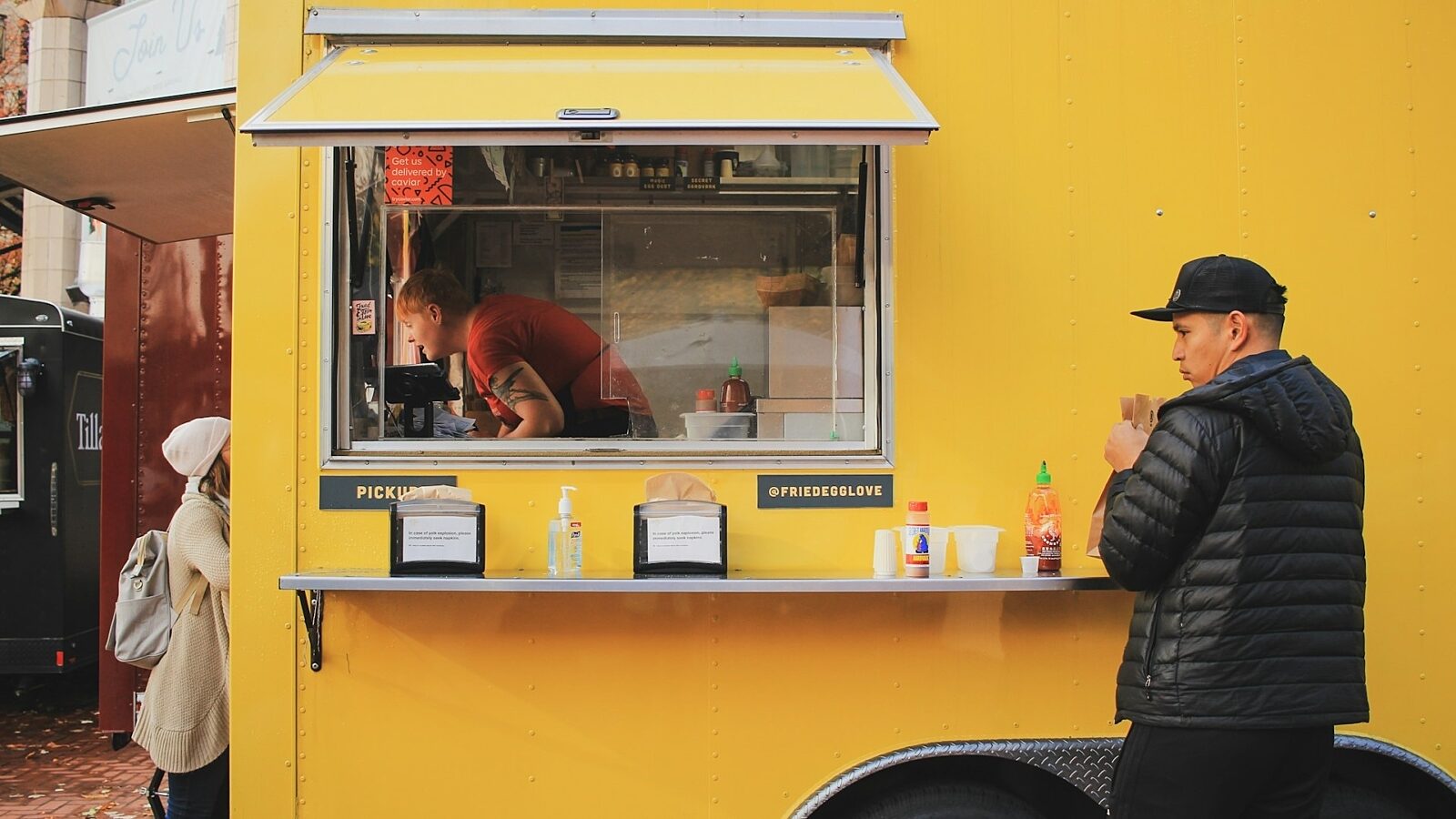
Food Truck Social Media: 9 Best Strategies For 2024
Let’s explore how to build your food truck social media strategy and the best tactics to consider.

Jim McCormickAuthor
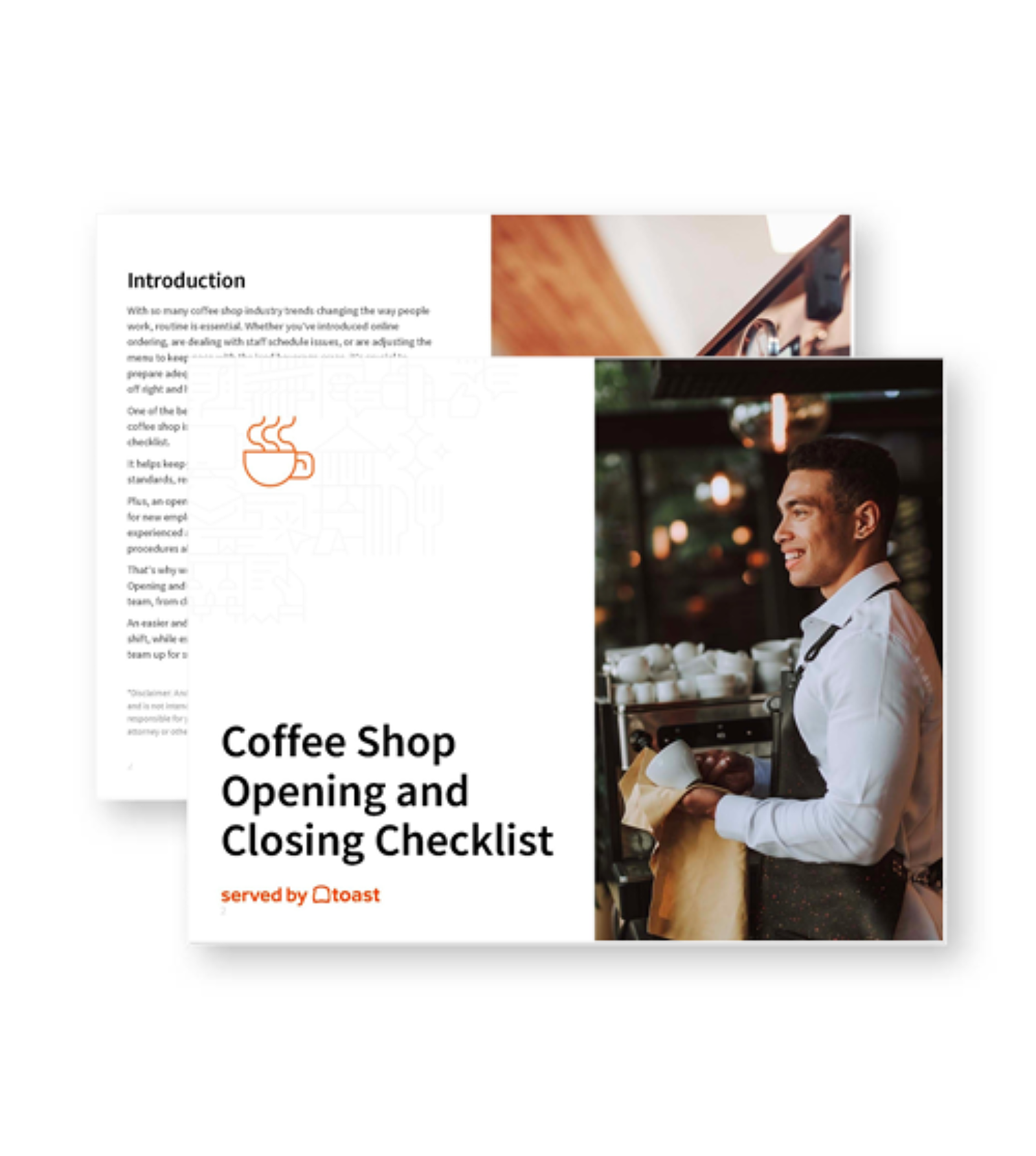

Food Truck Opening & Closing Checklist
The beginning and end of a shift can be frantic. Use this free PDF checklist to set your food truck staff up for success.
Get free downloadThe food truck industry has been one of the best-performing segments of the food service industry for the last five years. In fact, according to IBIS World, food truck industry revenue has grown about 13.3% in that time, reaching a total of $2.2 billion in 2023.
The market research firm also reports that this trend is likely to continue, as younger adults are more adventurous and looking for convenient, gourmet food options. Meanwhile, older adults are more likely to dine at sit-down restaurants.
Given that 84% of those aged 18 to 29 use social media, it’s key to establish a presence on these platforms in order to remain attractive to this growing market of younger, tech-savvy people.
With that in mind, let’s explore how to build your food truck social media strategy and the best tactics to consider. At the end, we’ll provide a few examples of food trucks making the most of their online presence to help you get started.
Food Truck Menu Templates
Use these food truck menu templates as a starting point for your menu design or to give your menu a refresh.

Key Takeaways
Social media is the perfect tool for keeping your customers up-to-date, helping new customers discover your business, and establishing the credibility of your food truck.
Before launching your social media profiles, think about what you’re hoping to accomplish by setting defined key performance indicators. Additionally, take time to understand your target audience, as well as research your competition.
Social media is great for showing off your products, special deals, and behind-the-scenes content. However, you can also use it to provide customer service, develop your brand’s personality, and encourage customer engagement through tactics like user-generated content.
Your social media strategy is only valuable if you provide a stellar customer experience to back it up. So, be sure to use the latest technology to create a seamless and memorable experience.
Why Should Your Food Truck Use Social Media?
Social media is vital for keeping your customers in the loop, whether your food truck has a permanent location or only appears at special events.
Beyond sharing critical information, it’s also the perfect opportunity to attract new customers and establish the credibility of your business.
Below, we delve deeper into why your food truck should use social media in its marketing strategy.
1. Share Key Updates
One of the most important reasons to use social media for your food truck is that you can share updates with your customers instantly.
This is especially key if your business only operates during certain events and constantly changes locations.
However, even if you’re at the same spot every day, it’s still a great way to let customers know about new menus or special promotions.
By posting critical information like this across your social media platforms, you can ensure customers are always up to date.
2. Improve Discoverability
Social media is also key for helping new customers learn about and discover your food truck. In fact, data from Statista indicates that nearly 93% of for profit-companies use social media to improve brand awareness. Meanwhile, nearly 70% use it to acquire new customers.
Since the food truck market can be quite competitive, building awareness of your brand is critical.
Additionally, if your truck changes locations each day, it’s key to let customers know where to find you.
On the other hand, if you’re in the same location each day, it’s important to list your address on your profiles. You might even consider using tools like Google My Business and Yelp to help searchers discover you. We’ll explain how this can be a valuable tool later.
You can also make use of key social media features, like hashtags and geo-tags, to help users find your business. Additionally, by encouraging customers to share your posts or their own user-generated content, you can expand your visibility to their followers.
Ultimately, by sharing high-quality images and videos of your dishes, you can entice those who find you on social media to give your food a try.
3. Establish Professionalism and Legitimacy
One more important reason your food truck should use social media is that it helps establish the credibility of your business.
According to Synup, 76% of local businesses use social media as part of their marketing strategy. Additionally, 96% of small businesses use social media in their marketing strategy.
Since so many other businesses are using it, it’s key that you do too so you can keep up with the competition.
Overall, regularly updated profiles with engaging content show that you are professional and committed to quality.
How To Build Your Food Truck Social Media Strategy
Guide to Restaurant Social Media Marketing
Learn how to optimize your social media presence to showcase your brand, tell your story, attract new customers, and engage with your audience.

Now that you have a better idea of how social media can benefit your food truck business, let’s explore how to set the foundation of your strategy.
Be sure to consider the following before you even make your first post.
1. Set Goals and KPIs
To make the most of a food truck social media strategy, it’s key to consider what you want to achieve with it in the first place. Some common goals may include:
Increasing foot traffic and sales
Boosting brand awareness
Engaging more with your community to develop better customer retention and brand advocacy
Once you have a good idea of what you’re trying to accomplish, you can identify key performance indicators (KPIs). These are measurable metrics that help you determine the success of your strategy.
Some KPI you may want to consider tracking include:
Follower growth, which can measure
Engagement rates
Number of direct messages received
To understand if your strategy is increasing foot traffic, consider offering a discount only available through your social media channels. This can help you measure the increase in foot traffic attributable to your social media strategy.
2. Research Your Audience
Targeting the right audience is critical to the success of any social media strategy, regardless of your industry. So, it’s vital that you research your ideal audience so you can better understand key information like:
Demographics
Interests
Behaviors
For example, is your food truck located in a permanent spot in an area with lots of tourists? Then it may make sense to emphasize the authenticity of your dishes so customers can try local cuisine.
In this instance, your demographic is tourists, their interest is authentic and local cuisine, and their behavior is seeking a unique and memorable food experience during their visit. So, you might tailor your social media presence to highlight local ingredients and share the cultural significance of your offerings.
On the other hand, a food truck located in an area with lots of busy professionals may want to highlight convenience, fast service, and friendly customer service.
In this instance, your demographic is busy professionals, their interest is convenient food, and their behavior is seeking quick meals. You might tailor your social media presence to these customers with behind-the-scenes content showing how fast you make your food, or using customer testimonials attesting to the quality.
Ultimately, the social media strategies your food truck employs should cater to your specific audience.
3. Analyze Your Competitors
It’s also to study your competition to see what they’re doing on social media. This can help you identify their strengths and weaknesses, allowing you to see what tends to work best in your market.
For example, is there another local food truck with tons of followers and engagement on their posts? Then study what kind of content they post to learn why they’ve been successful, and consider creating similar kinds of content for your accounts.
By understanding what your competitors are doing, you can differentiate your food truck and give customers a reason to choose your business over the competition.
4. Create a Content Calendar
Finally, it’s a good idea to create a content calendar. This will allow you to plan your posts ahead of time, ensuring consistency and variety in your content.
By scheduling posts, you’ll always be prepared to share content without a last-minute scramble.
To create your calendar, start by outlining the key events and promotions you want to highlight each month. For example, if there’s a holiday coming up, you may want to run a holiday-themed promotion.
Additionally, the calendar will give you a timeline for making other types of content, like behind-the-scenes demonstrations or employee interviews.
By scheduling these things out ahead of time, you can make sure you’re posting regularly and keeping your followers engaged with your brand.
Opening a Food Truck Checklist
So many things go into opening a food truck. With this free PDF checklist, you'll set your new business up for success.

9 Best Food Truck Social Media Strategies
There are lots of social media strategies your food truck can implement, and we discuss some of the most effective ones below.
Depending on your specific business, some of these tactics may work better than others. So, be sure to test out different content formats to see what resonates best with your audience.
Additionally, keep an eye out for new trends, and see how you may be able to incorporate them into your plan.
1. Showcase Your Offerings
One of the most important content types you should post on your social media accounts is pictures and videos of your offerings.
After all, this is the perfect chance for you to showcase your dishes in the best possible light. You can entice customers to visit your food truck through mouth-watering images of your tacos, or attract them with videos drizzling hot sauce over some chicken and rice.
If possible, try using natural lighting and a clean background to showcase your food properly. Additionally, think about using a consistent filter or editing style to maintain a cohesive look.
2. Highlight Your Vendors
Beyond sharing content showcasing your finished dishes, you might also consider highlighting your vendors. This can be especially effective if you use local partners, as it can add a layer of local appeal to your brand.
On the other hand, if your food truck focuses on international cuisine, consider highlighting any international vendors to add another layer of authenticity to your products.
Overall, sharing vendors’ stories, the quality of their products, and how they contribute to your menu can be an excellent social media strategy.
3. Promotions
Of course, social media promotions are another great strategy for attracting more customers to your food truck.
For example, you might create a buzz around seasonal dishes, limited-time menu items, or other discounts. Likewise, if your food truck is going to be at an upcoming event, it’s also a good idea to share details about that event.
To generate excitement, consider using content like countdowns, sneak peaks, and behind-the-scenes videos.
By building anticipation and highlighting that an offer is time-sensitive, you can encourage a sense of urgency and exclusivity amongst your followers. This can get them to visit your food truck sooner, and may even encourage them to come back multiple times before the deal expires.
You can also encourage followers to sign up for your email list by offering incentives like discounts or exclusive previews. Once you have their email, you can communicate with them directly in their inbox, ensuring they see all of your communications.
4. Develop A Brand Voice
Developing a consistent brand voice is another key consideration when creating your social media presence.
Keep in mind, however, that your brand voice will differ based on your target audience and the personality you want to communicate.
For example, if your food truck caters to tourists, you likely want to go with a friendly and informative tone, showcasing the authenticity of your food.
Meanwhile, a food truck with a younger and more trendy audience may want to adapt a humourous or slightly edgy tone, incorporating slang and jokes in their messaging.
Regardless of what tone you go for, be sure to keep it consistent across all of your social media channels.
5. Behind-the-Scenes Content
Another great type of content your food truck can post on social media is behind-the-scenes content.
Some examples of behind-the-scenes content might include:
Employee Spotlights: Introduce your team through pictures or short videos highlighting their roles, favorite dishes, and fun facts about them.
Daily Operations: Share photos and videos of fun moments from your everyday operations, or show your staff hard at work to display the effort that goes into operating the business.
Food Preparation: Give followers a glimpse of your culinary process, sharing step-by-step food preparation videos or highlighting unique techniques and ingredients.
This is a great strategy for helping build your brand voice. For instance, a fun and lighthearted brand may want to focus more on posting funny moments from daily operations.
Meanwhile, a brand voice emphasizing authenticity may want to pay more attention to sharing the cultural background of its employees or owners.
Ultimately, behind-the-scenes content can help show the human side of your business, helping customers build a deeper connection with your brand.
6. User-Generated Content and Customer Engagement
One of the reasons social media is such an effective marketing tool is that it allows you to interact directly with your customers. So, be sure to engage with your followers regularly.
For example, try replying to all comments, messages, and mentions as quickly as you can.
Additionally, aim to post multiple times per week to ensure you stay on your followers' radars. Social media algorithms tend to promote pages that post consistently, which can also help improve your accounts’ visibility.
Likewise, the algorithm will treat you more favorably if your posts receive high levels of engagement, as this indicates high-quality content.
So, consider tactics that can increase follower engagement, such as posting questions or polls to spark conversation. For example, you might ask “What’s your favorite burger topping?”, or run a poll asking followers to choose their favorite dish from a list of four choices.
Of course, follower engagement goes beyond appealing to algorithms. For instance, you can encourage user-generated content. This allows customers to share their experience at your food truck and tag your business to improve visibility amongst their followers.
Additionally, you can repost their photos and videos to build community and credibility for your food truck.
Finally, to encourage user-generated content, consider tactics like social media contests and giveaways to increase engagement. For instance, tell customers they can win a free meal by sharing a photo and tagging your business.
7. Customer Support
Not only can your food truck use social media to engage customers, but you can also use it to help them by responding to comments and messages.
For instance, if a customer has questions about your operating hours or location, you can encourage them to message your account directly for further clarification. Likewise, you can deal with any customer issues and seek resolutions.
It’s also a good idea to reply to customer reviews. For positive reviews, be sure to thank customers publicly to make them feel valued.
On the other hand, for negative reviews, address their issues publicly, and encourage them to reach out so you can resolve their problem. By addressing concerns publicly, you can show other customers that you’ve resolved the issue and that you take feedback seriously.
If you’re able to find a solution to their problem, disappointed customers may even update their review, which can help with your reputation management.
Overall, by using social media as a customer service tool, you can improve customer satisfaction and encourage repeat business.
8. Paid Ads
While you can implement most of the strategies we’ve discussed above for free, you might also want to consider trying paid ads.
Advertising tools on platforms like Facebook and Instagram allow you to target specific demographics, such as:
Location: You can set your ad campaign to only show ads to those located within a specific radius of your city.
Age: You can choose the age range of people who will see your ads.
Interests: If your food truck emphasizes vegan options, you can target users interested in vegan food offerings
Behavior: If your food truck only sets up during events, you can target people based on “interested in upcoming events” to show your ads to people looking to go out.
By using the targeting features above, you can narrow your audience to ensure you’re reaching the right people.
Food Truck POS Comparison Tool
A free, customizable Food Truck POS Comparison Tool to research and compare point of sale systems in one Excel spreadsheet or editable PDF.

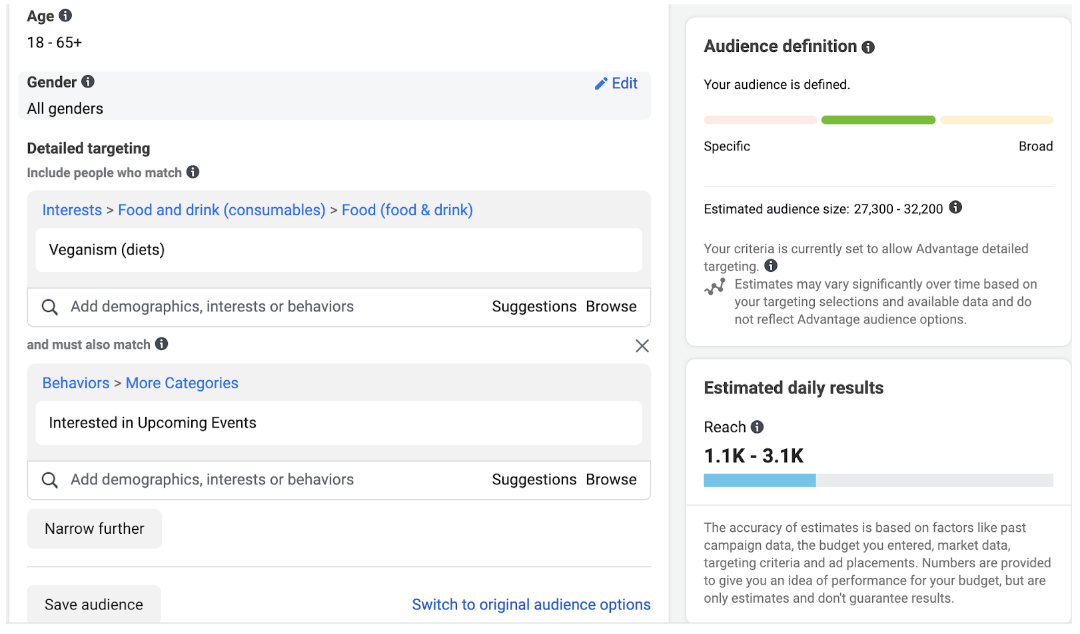
Better yet, Facebook will provide you with an estimated audience size and daily estimated results based on your budget. The budget in the example above is set to just $5 a day, but will reach between 1,000 and 3,000 users each day.
After starting your campaign, you can also check out their analytics tools to understand how its performing. From there, you can adjust your targeting specifications or content to optimize performance.
1. Influencer Marketing
One more great social media strategy for your food truck to consider is influencer marketing. This involves collaborating with another social media user with an established following to get in front of their audience.
To pursue this tactic, the first thing to do is find an influencer with followers relevant to your niche. In your case, these profiles should showcase local food and things to do in your area. Additionally, you should think about:
Audience Alignment: Seek influencers whose followers match your target demographic, like age, location, interests, and engagement patterns.
Engagement Rates: Evaluate the influencer’s engagement rates, not just their follower count. Higher engagement indicates a more active and loyal audience.
Content Quality: Assess the quality of the influencer’s content. Ensure their style, tone, and visuals align with your brand’s image and values.
Reputation and Professionalism: Investigate the influencer’s reputation and previous brand collaborations. Look for influencers with a positive track record and avoid those with unprofessional behavior.
Once you identify some potential influencers, you can reach and propose a mutually-beneficial collaboration. Be sure to craft a personalized outreach message showing appreciation for their work, mentioning specific posts or campaigns that caught your attention.
Then, include a proposal for collaboration identifying:
Clear objectives, such as increasing brand awareness or driving more foot traffic
Expectations, such as how you’ll measure success (ie, KPIs) and a clear outline of deliverables
The type and quantity of content you expect them to create, such as two Instagram Reels videos and two TikTok videos
Key messages you want them to convey
Timeline for creation and posting
Ownership and usage rights for the content
Compensation or any other benefits
Finally, if the campaign is a success, consider building long-term relationships with influencers. Ongoing partnerships can create a more consistent and impactful brand presence.
Best Food Truck Social Media Platforms
Most of the strategies we discussed above can be effective, regardless of the social media platform you use.
Now, let’s take a look at some of the key platforms you should consider using, as well as some advice for making the most of each one.
1. Google My Business and Yelp
Even though Google My Business isn’t technically a social media platform, it can still be a great tool for enhancing your online presence and improving the discoverability of your business.
For example, a searcher on Google might look up the term “food trucks near me.” Then, the search engine will provide them with a list of nearby food trucks.
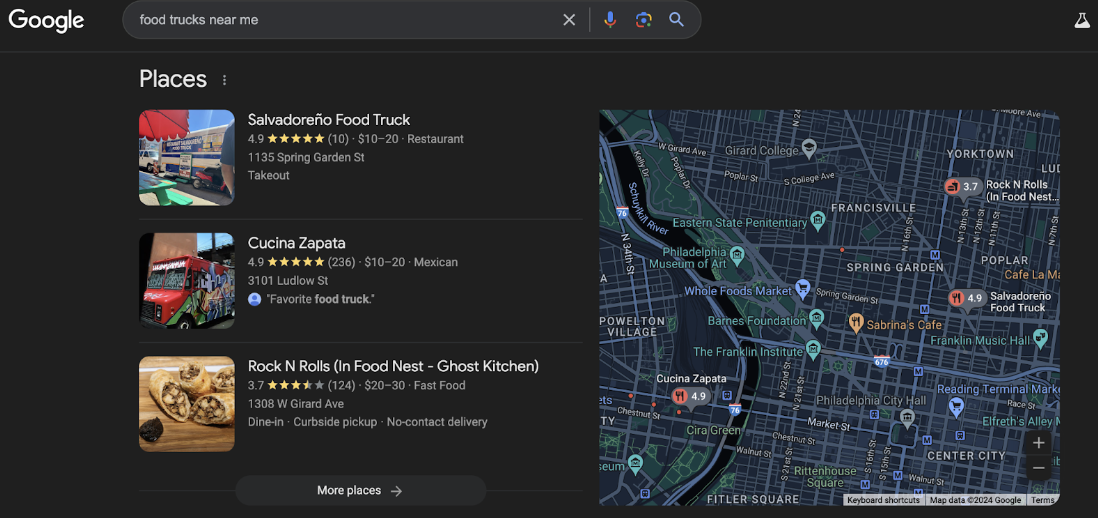
Now, there are a lot more food trucks than this in Philadelphia. However, because many of the businesses aren’t using this tool, it’s an excellent opportunity to stand out.
Additionally, you might consider making use of platforms like Yelp, which can also help people discover your business online.
Just keep in mind that these tools will only really work for food trucks with a regular location. For those that only pop up during special events, you’ll want to make use of more traditional social media platforms.
1. Instagram
Instagram is all about visually-appealing content, so you’ll want to use high-quality photos and videos to showcase your food, truck, and customer experiences.
You can also use Instagram Stories to post quick daily updates to keep your followers in the loop. For example, if you’re offering a special deal today, let customers know with a Story. It’s a great way to quickly update followers, and the Story will expire after 24 hours.
Additionally, Instagram Reels are perfect for creating shareable content. Adam Mosseri, head of Instagram, recently said:
“We do a number of different things on Instagram but at the heart of it there are really two jobs. One: connecting you with friends. Two: helping you explore your interests, usually through short form video. It turns out that those two things are symbiotic…. I see a highlight of an amazing soccer goal or trick, and I send it to someone who I know loves soccer as much as I do. So these things are about connecting with friends over your interests.”
Think about how your food truck can use the advice above. For example, consider sharing videos of your unique food offerings that people haven’t seen anywhere else. Once a user sees it, they should want to send it to their friend and say something like “We have to try this!”
Finally, be sure to use your Instagram to bio to full effect by including all your key business information, such as:
Location
Call to action (for example, “Visit us today!”)
A link to your menu, website, and/or upcoming events
2. Facebook
Facebook is another great platform for promoting your food truck and engaging with followers.
If your food truck only pops up for events, the Facebook Event feature is a great tool for getting customers interested. You can even invite all of your followers directly to ensure they’re in the loop about upcoming events.
Additionally, you can encourage customers to message your account directly to get answers to any questions they may have.
This social media platform also has a review feature, where customers can rate your food truck. By encouraging customers to leave positive reviews, you can establish social proof, which may entice others to give your business a try.
To make the most of your Facebook presence, be sure to set up your page and include key information, like:
Location
Contact Details
Operating hours
Links to your menu or website
Links to your other social media platforms, like Instagram, to encourage engagement across different platforms
You’ll want to be sure to post frequently, typically at least three or four times a week, to keep followers engaged. You should respond to comments to encourage even more engagement.
3. TikTok
TikTok is all about harnessing the power of short-form videos. This platform can be especially effective for targeting younger audiences. Statista reports that about one-third of TikTok users are between the ages of 18 and 25, while just 4% are 46 or older.
Like Instagram Reels, you’ll want to create content that users want to share with their friends. This might involve sharing videos showcasing:
Unique and mouth-watering food offerings
Your cooking and food preparation process
Customer reactions
Additionally, you might consider participating in trending challenges and using popular sounds to increase your visibility. You can also encourage engagement by replying to comments and collaborating with other TikTok users.
Overall, TikTok is an excellent platform to get creative and highlight what makes your food truck stand out.
4. Other Social Media Platforms
While the social media platforms we mentioned above are some of the most popular and effective marketing tools for food trucks, you should also consider other platforms.
For example, you might consider trying out:
X (formerly Twitter): Use X for real-time updates and customer service. Share quick updates about your location, daily specials, and events. Engage with followers through retweets, replies, and hashtags.
Pinterest: Create boards that feature your menu items, recipes, and food truck events. Use high-quality images and detailed descriptions to attract food enthusiasts and drive traffic to your other social media platforms.
YouTube: YouTube has the second-highest number of monthly active users of all platforms, falling just short of Facebook. You can develop longer-form content such as cooking tutorials, behind-the-scenes videos, and customer testimonials. Overall, YouTube allows for more in-depth storytelling and can help build a loyal following.
Ultimately, by experimenting with different platforms, you’ll have a better chance of reaching the right audience.
3 Inspiring Food Truck Social Media Examples
At this point you should have a good idea of the different social media platforms and strategies you can use for your food truck.
Lastly, let’s take a look at some inspiring examples of food truck social media. As we explore them, think about how you may be able to incorporate various elements into your own strategy.
1. Kogi BBQ (Facebook Inspiration)
If you’re looking for inspiration for your food truck’s facebook account, Kogi BBQ is an excellent example. They post a diverse array of content types to their page, in addition to posting multiple times per week.
For example, they shared this post with special deals for The Super Bowl.
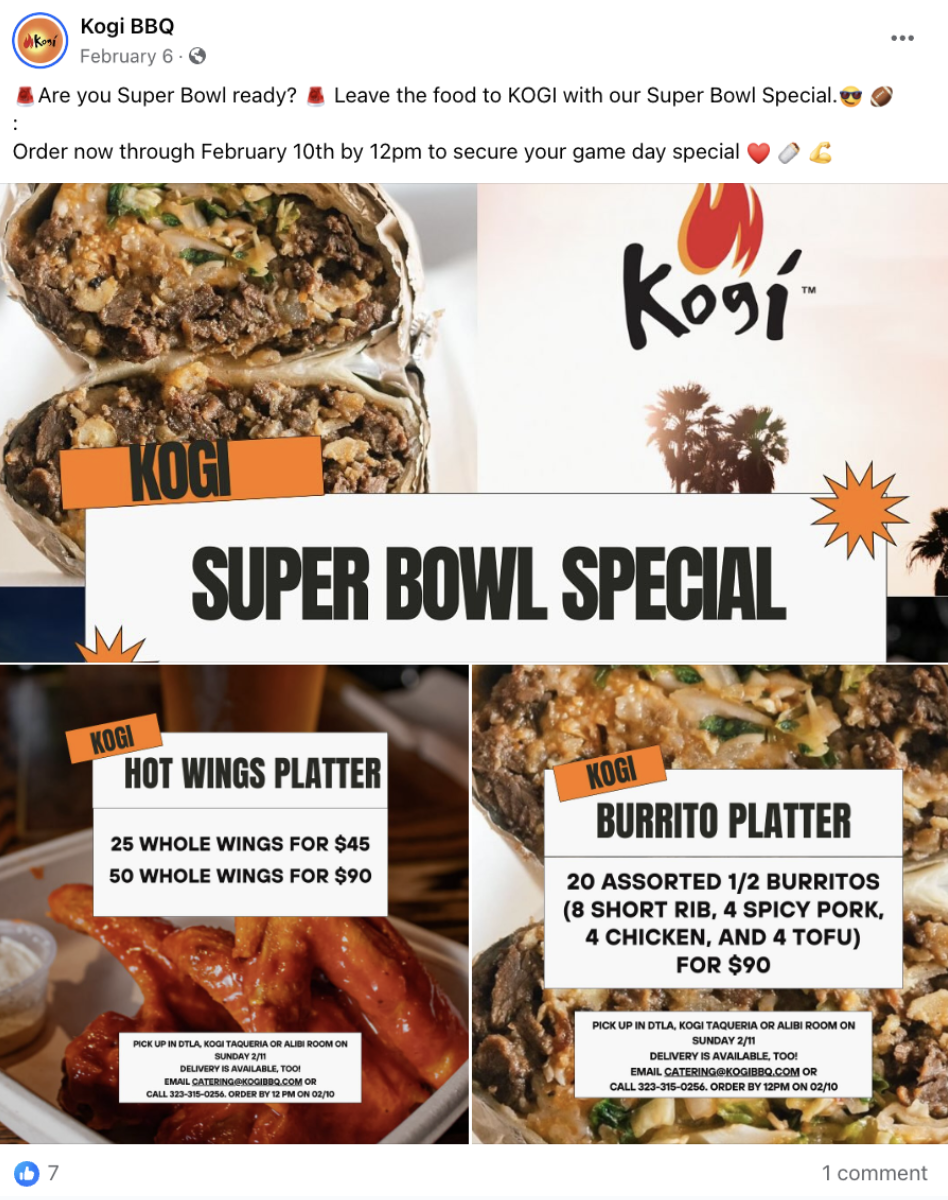
The example post above not only shows off images of their products but also lets customers know about their special deals.
Likewise, they also promote their catering services with some behind-the-scenes content.

By giving a glimpse into their food preparation process, they help potential customers see the quality of their offerings and the hard work that goes into making it. This can entice followers with upcoming events to book Kogi for catering.
Of course, this food truck also does a great job of showcasing user-generated content.
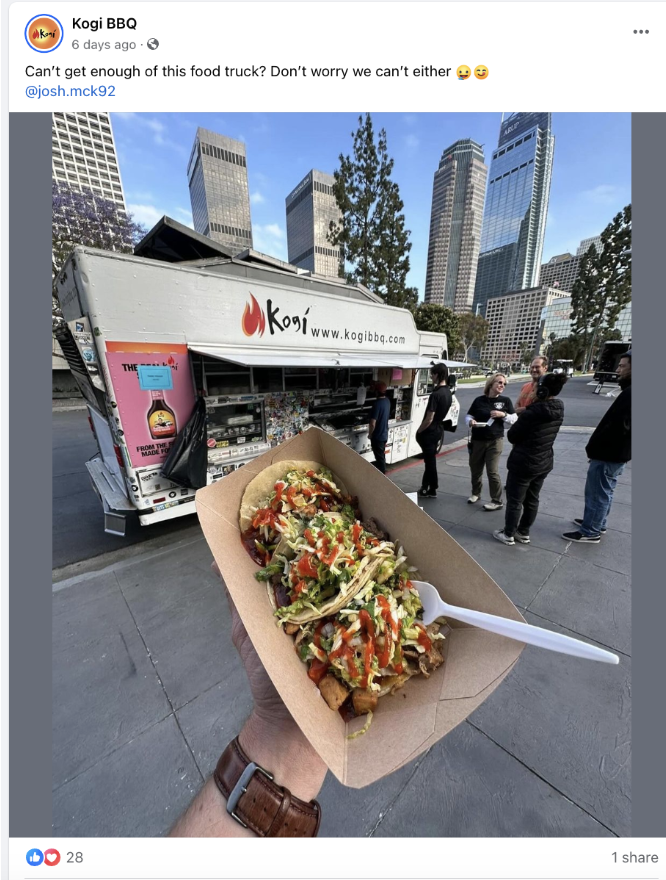
The example above is effective because it shows off their yummy-looking tacos, as well as the ambiance of the food truck. Additionally, they tag the customer who took the picture, which could help this person feel valued and encourage other customers to share similar content.
The post also works as social proof, showing that the customer loved the food so much they just had to share it online.
Finally, Kogi BBQ does a great job of optimizing its profile’s bio.
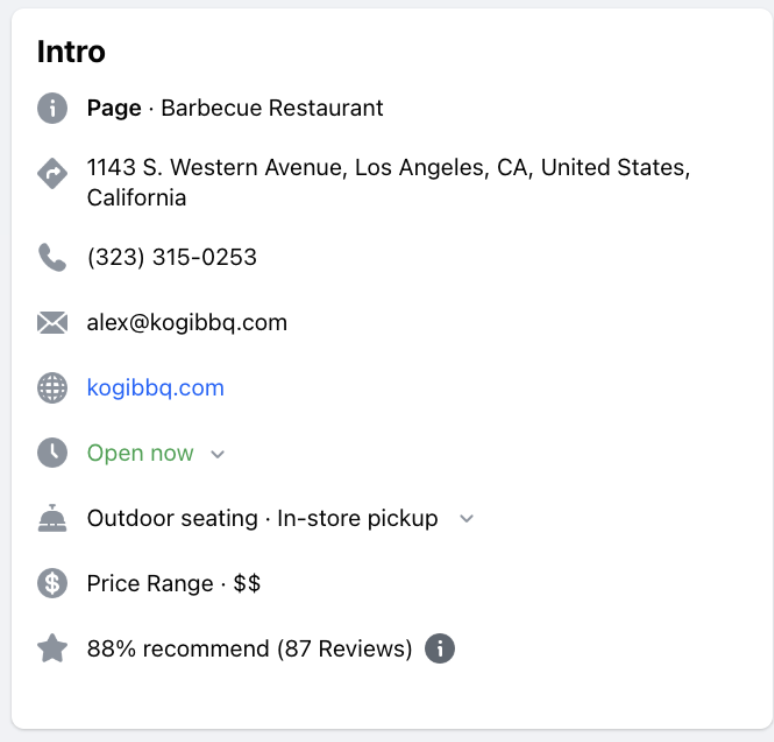
They made sure to include all of their essential business information, such as:
- Location
- The type of food they serve
- Contact information, like phone number and email
- Operating hours
- A link to their website
2. K’Town Pub Food Truck (Instagram Inspiration)
Unlike Kogi BBQ, the K’Town Pub Food Truck doesn’t have a permanent location. Instead, they only operate the truck at specific events.
Fortunately, they do a great job of communicating their upcoming events through their Instagram page.
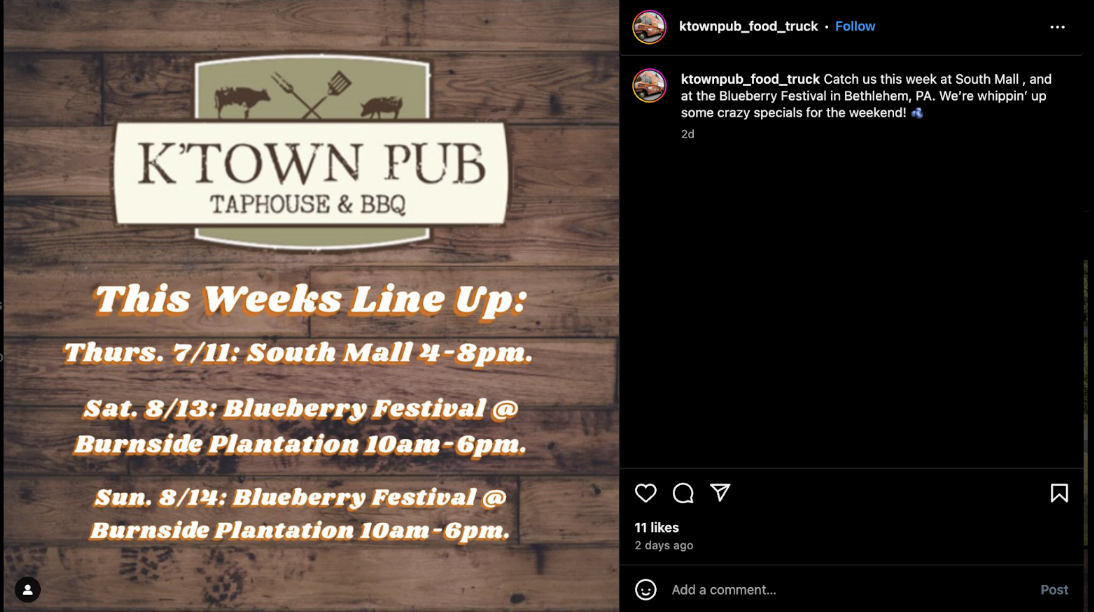
Though the example post above is simple, it clearly communicates key event information, like location and time.
Additionally, this Instagram account includes high-quality pictures of their food, enticing customers to come check them out.

They even mention other food that’s available at their truck, as well as sharing event details.
Of course, the K’Town Pub Food Truck also shares pictures of their vehicle, so followers know what to look for if they come to the event.
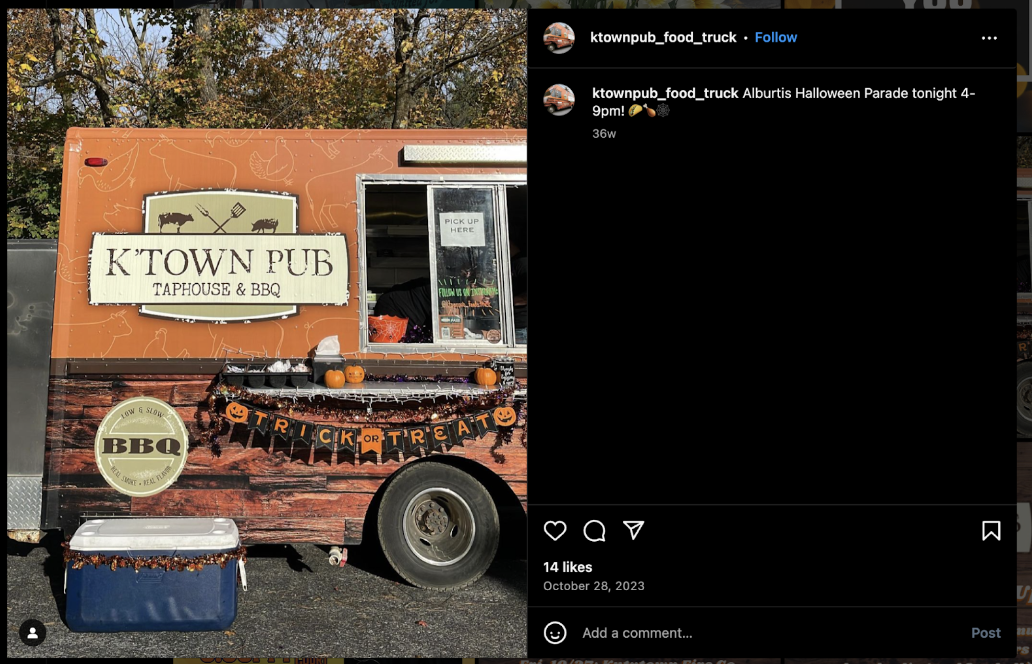
Since the food truck is operated by The K’Town Pub, they also do a great job of integrating this page into their main business’ Instagram profile.

Smartly, they include a mention of the food truck on their main profile, which users can easily navigate to. Overall, this promotes synergy between both the dine-in establishment and pop-up food truck business.
Finally, it’s worth noting that they do a good job of optimizing their bio. They include:
- Contact information
- What they do (ie, private events, breweries, wineries, festivals, catering)
- A link to their main website
3. TurnUp Food Truck (TikTok Inspiration)
TurnUp Food Truck is located in Johannesburg, South Africa, and they can provide amazing inspiration for your food truck’s TikTok presence. They currently boast about 13,000 followers, and their videos consistently get tens of thousands of views.
This business has a large focus on catering corporate events, and they do a great job showcasing the vibe at their events.
https://www.tiktok.com/@turnupfoodtruck/video/7372614895969242374
Not only do they show their customers having a fun time, but they also highlight their food, behind-the-scenes preparation, and their truck.
Additionally, they implement other social media best practices, like contests and giveaways.
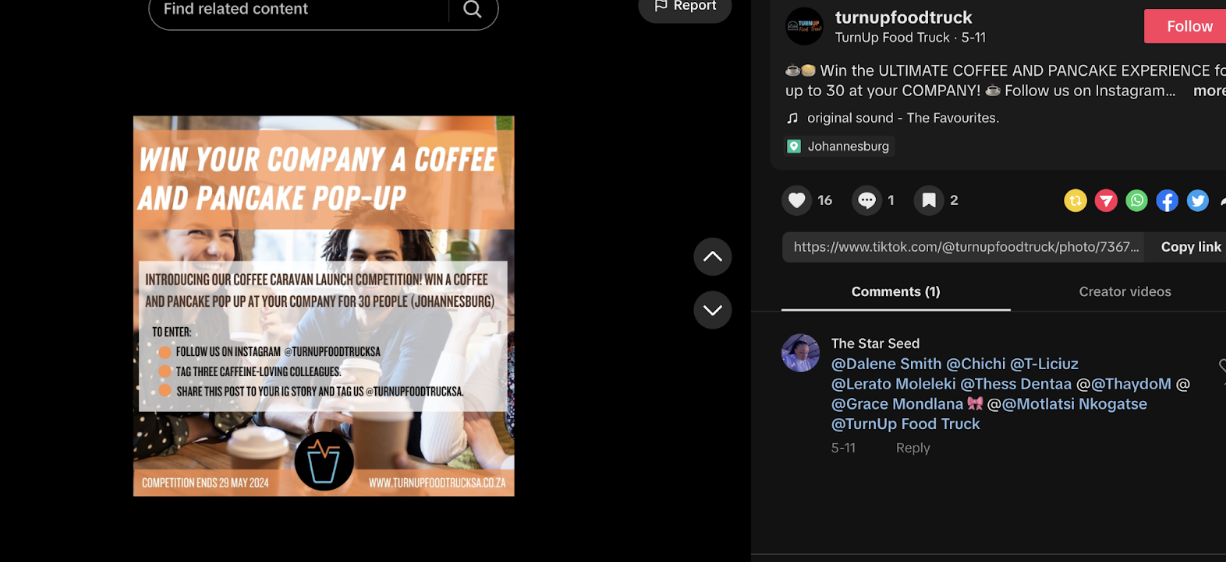
In the example above, they promote their contest offering the winner a coffee and pancake pop-up. They made the same post on instagram, and promoted cross-channel engagement by telling followers they can win by following them on Instagram, tagging their friends, and sharing the post.
TurnUp Food Truck also optimizes their profile by using attention-grabbing thumbnail images.
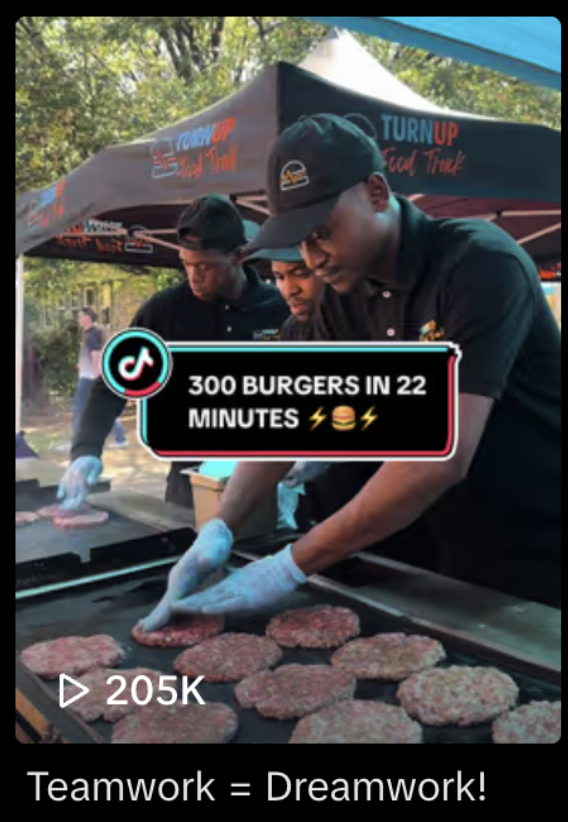
The example above uses the phrase “300 burgers in 22 minutes,” which can entice people to watch the video to see how they accomplished this impressive feat. The video has performed quite well, boasting over 200,000 views and over 6,000 likes.
Finally, this business does a good job of optimizing their TikTok bio by including:
- Their location
- What they are (“The Freshest Food Truck in Johannesburg!”)
- A link to their website

The only improvement they may want to make is to link to their instagram account from their TikTok bio, which can encourage engagement across channels. This would be especially effective given their contest which requires participants to follow and share their Instagram account.
Combine Your Food Truck Social Media Strategy With Cutting-Edge Technology
Your food truck social media strategy is the perfect tool to attract new customers and build deeper relationships with existing ones. Additionally, it’s a great way to share key updates as well as establish the credibility of your business.
Remember, though, that the best way to keep customers coming back for your tasty food is by delivering an exceptional customer experience.
With a robust POS system like Toast, you can take your food truck to the next level by incorporating online ordering, catering and event management tools, and much more!
To learn all the ways Toast’s solutions can improve your business, check out all of the amazing features.
Related Resources
Is this article helpful?
DISCLAIMER: This information is provided for general informational purposes only, and publication does not constitute an endorsement. Toast does not warrant the accuracy or completeness of any information, text, graphics, links, or other items contained within this content. Toast does not guarantee you will achieve any specific results if you follow any advice herein. It may be advisable for you to consult with a professional such as a lawyer, accountant, or business advisor for advice specific to your situation.
Subscribe to On the Line
Sign up to get industry intel, advice, tools, and honest takes from real people tackling their restaurants’ greatest challenges.
